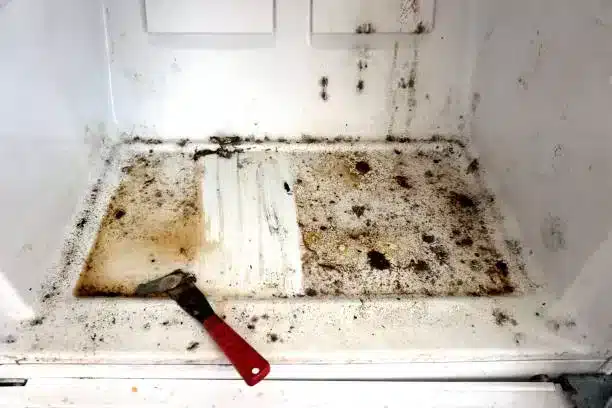
Mold can grow in the freezer if the freezer is not working properly, unplugged for a long time, or opened and closed frequently. Mold can survive low temperatures in the freezer, but it cannot grow or spread. However, when the temperature in the freezer rises, mold can reactivate and resume its growth and reproduction.
Mold needs three things to grow: moisture, organic matter, and warm temperature. Moisture provides the water that mold needs to survive and spread. Organic matter provides the food that mold needs to feed and grow. Warm temperature provides the optimal condition that mold needs to thrive and reproduce.
In a freezer, moisture can come from various sources, such as condensation, ice buildup, water leakage, or food spillage. Organic matter can come from various foods, such as fruits, vegetables, meat, cheese, bread, or leftovers. Warm temperature can come from various situations, such as power outage, malfunctioning thermostat, faulty door seal, or frequent opening and closing of the freezer door.
When these three factors are present in the freezer, mold spores can land on the moist and organic surfaces and start to grow. However, mold growth in the freezer is usually slow and limited due to the low temperature. Low temperature can deactivate mold spores and prevent them from growing or spreading. However, low temperature cannot destroy mold spores or kill them completely.
This means that mold spores can remain dormant in the freezer until the temperature rises. When the temperature in the freezer rises above 40°F (4°C), mold spores can reactivate and resume their growth and reproduction. This can happen when the freezer is unplugged for a long time, when the freezer is not working properly, or when the freezer is opened and closed frequently.

Mold growth in the freezer can be prevented by controlling the three factors that mold needs to grow: moisture, organic matter, and warm temperature. Here are some tips on how to prevent mold growth in the freezer:

Mold can grow in the freezer if the conditions are favorable for it. However, mold growth in the freezer is usually slow and limited due to the low temperature. Low temperature can deactivate mold spores but not destroy them completely. When the temperature in the freezer rises above 40°F (4°C), mold spores can reactivate and resume their growth and reproduction.
To prevent mold growth in the freezer, you should keep your freezer clean, dry, cold, and organized. You should also check your food regularly for any signs of mold growth or spoilage and discard them as soon as possible.
